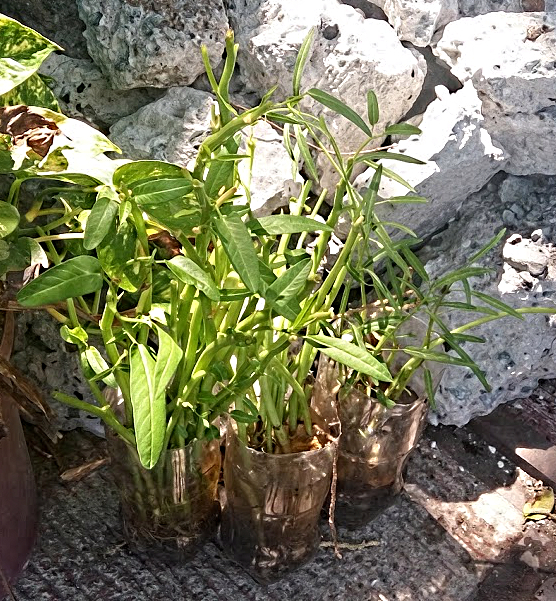
When you buy a bunch of kangkong tops from the market, and prepare it in the kitchen for, say, sinigang or adobo, don’t throw away the thick and tough but still-green stems from which you pinched off the tender shoots and leaves.
Rather, soak them in standing position inside some vertical container with maybe 3-5 inches of water. I myself use Coke Litro or Sprite Litro plastic bottles, with the upper third cut off. Place the upright stems—now partially submerged in your improvised containers; make sure that they’re really right-side up—in the sunniest spot inside (or better yet, outside) the house. After a couple of days, you’ll notice that the stems have begun to sprout new buds, as well as tiny white roots underwater. This means they’re alive and growing.
Encourage better growth by throwing away the stale water (together with mosquito larvae that might have hatched there) regularly, and replacing it with fresh water. Growth is also spurred by adding one or two cupfuls of soil to the water once the roots are a couple inches long. The soil will quickly settle to the bottom and thicken around the bunch of stems, roots and rotting matter.
In a week’s time or even less—depending on your climate zone and length of daytime—you will have raised a miniature garden of semi-aquatic kangkong. This should provide a dash of fresh green every day to your tired eyes, and also a dash of fresh green every week to your tired dishes. If you do decide to harvest, do it very modestly. Get only the smallest tops so that your kangkong garden can survive longer.
In my experience, sooner or later the kangkong plants raised this way will slowly die off. Sad but true. it maybe due to the poor quality of soil nutrients in such an improvised bottle ecosystem. Maybe the water should be refreshed more regularly. Or maybe the plants can’t reach some undefined critical mass to sustain itself when I harvest its leaves too frequently. I’m not sure what is it I’m doing wrong, really.
But once you get the hang of it, you can extend the life of the original bunch for, oh maybe 3-4 months, and squeeze at least 3-4 modest harvests from it. Tipid na, tiyak pang sariwa. Sikat ka pa, for having made a first effort to “plant what you eat” even without a spacious garden. And who knows, you might discover a simple breakthrough solution to the above-mentioned “terminal bottle” problem so that your kangkong garden could grow sustainably from one year to the next, without your having to invest in high-tech aquaponics.
So go ahead and try it. You have nothing to lose but your huge plastic bottles and your fear of home-grown veggies. #

